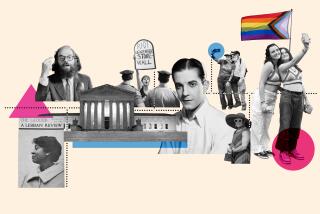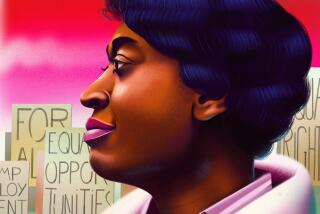Review: ‘When We Rise’ makes the gay rights movement part of a universal struggle
Gay storylines on network television aren’t always frivolous, but it’s rare when they embody themes that are universal to us all — no matter if you identify as LGBTQ, SWM, SWF or any other acronym.
ABC’s four-part miniseries, “When We Rise,” chronicles the gay rights movement as a shared part of America’s history, from its early protests against police brutality in 1970s San Francisco to the same-sex marriage ruling by the U.S. Supreme Court in 2015.
“When We Rise,” which premieres Monday, is a history lesson wrapped in a human drama. It takes half a century of struggle and compresses it into a powerful and moving story set during the last wave of the civil rights movement.
Based on the life stories of LGBT activists Cleve Jones (Guy Pearce), Ken Jones (Michael Kenneth Williams) and Roma Guy (Mary-Louise Parker), “When We Rise” juxtaposes their fight for equality and representation with their longing for love and stability.
The personal is political here, and that makes the series feel as intimate as it does topical. The discriminatory practices that spur the protests depicted in “When We Rise” are again being pushed at the highest levels of government, and again resulting in resistance movements. If only it was a cinematic déjà vu.
Each two-hour episode never misses an opportunity to reiterate, in subtle and not so subtle ways, that none of us is equal until we all share the same protections and freedoms. It’s a running theme of writer Dustin Lance Black, who won an Oscar for his biopic “Milk” about the first openly gay elected official in California, Harvey Milk.
The series kicks off in the early 1970s, when antiwar activist Cleve Jones leaves his repressive life in Phoenix for the liberal San Francisco he’s read about in Life magazine. Vietnam vet and sailor Ken Jones has been reassigned by the Navy to San Francisco where, as an African American, he’ll head a desegregation program. Roma Guy is an East Coast member of NOW, but when the feminist organization rejects lesbians, she too moves west to join a more progressive arm of the cause
“The peace movement kids, the women’s rights movement, the civil rights fighters, all the outsiders and outcasts,” says Cleve during a narrated interlude. “Everything we read told us that San Francisco is where we, the ‘us’es, could find safe harbor.”
But the Summer of Love has given way to “the winter of heroin.” The activism of the ’60s has faded, gay men are being abused by police and victimized by those perpetrating hate crimes. Lesbians are considered even less worthy of rights than women.
Cleve, Ken and Roma — all played in their youth by the relatively unknown actors Austin P. McKenzie, Jonathan Majors and Emily Skeggs, respectively — become organizers who pool their leadership skills and followings to rally in unison for lesbian and gay causes.
Cultural touchstones such as turkey-baster babies and bath houses are referenced here, as well as legislation like Proposition 6, meant to ban gays and lesbians from working in California public schools. The characters successfully lobby against the bill, and for the election of Milk for city supervisor. When he’s murdered in office, they find even more cause to rally for fair treatment in the eyes of the law.
By the 1980s, the Castro neighborhood is a safe haven for the LGBT community, hate crimes are down and the police are protecting instead of harassing the community. But the AIDS epidemic hits, and being young and gay once again proves a deadly combination.
Cleve and Ken, who both find they’re HIV positive, watch their longtime partners succumb to the disease. The government ignores the growing epidemic, partly because it’s considered a gay disease. Cleve creates an AIDS quilt to memorialize those who’ve died and to draw national attention to the crisis. It’s also the military’s “don’t ask, don’t tell” era, and as a gay man, Ken has trouble accessing the healthcare he needs. Roma uses the clout she’s gained lobbying for previous causes to push for low-cost and free healthcare. As all three civil rights veterans move into the 2000s, the once unthinkable victory of same-sex marriage becomes a reality.
Though the star power doesn’t arrive until the last two episodes, it’s the first half of “When We Rise” that is riveting. The early years are passionate and filled with urgency, mirroring the excitement and promise of an era still basking in the glow of the optimistic ’60s. The grind of adulthood, and its responsibilities, is sometimes all too real in the second half.
The abrupt transition from the younger cast to the older actors is also jarring because they look and act like different people, so it’s up to the viewer to forget the past and make that leap. Still, the love scenes throughout — not just sex, but intimacy as well — artfully push the boundaries of what network TV is usually willing to show between same-sex couples.
“When We Rise” is the most impactful LGBT-centric series since HBO’s “Angels in America” more than a decade ago. Sure, it’s a small playing field, but a notable one given the challenges of today.
‘When We Rise’
Where: ABC
When: 9 p.m. Monday
Rating: TV-14-DLSV (may be unsuitable for children under the age of 14 with advisories for suggestive dialogue, coarse language, sex and violence)
More to Read
The complete guide to home viewing
Get Screen Gab for everything about the TV shows and streaming movies everyone’s talking about.
You may occasionally receive promotional content from the Los Angeles Times.







